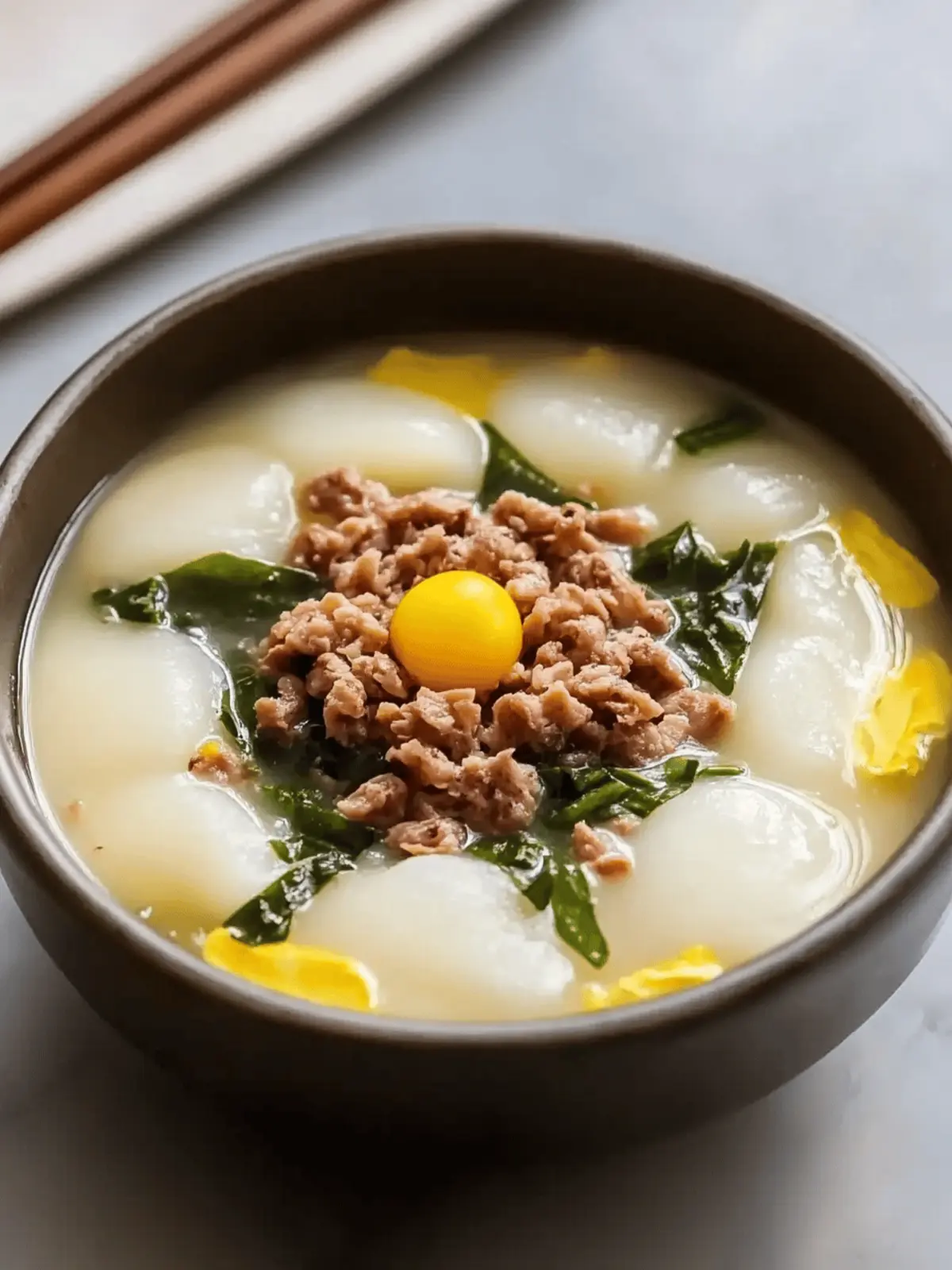As the first signs of the Lunar New Year approach, I can’t help but think of the warm embrace of Korean Rice Cake Soup (Tteokguk 떡국). The moment you lift the lid off the pot, the enticing aroma fills the kitchen, wrapping you in a sense of nostalgia and joy. There’s something incredibly comforting about the chewy texture of the rice cakes nestled in a savory broth, whispering promises of good fortune and fresh beginnings. I first learned this recipe during a chilly winter day, and it quickly became my go-to for cozy celebrations.
What I love most about Tteokguk is its incredible adaptability. Whether you’re vegetarian, craving a heartier version with beef or mandu, or simply looking to brighten a weeknight dinner, this dish has you covered. It effortlessly transforms into whatever you need it to be. Join me as we explore this delightful soup that’s not just a dish but a slice of tradition, ready to warm your heart and home.
Why is Korean Rice Cake Soup special?
Comforting Tradition: Tteokguk is not just a meal; it’s a comforting tradition that symbolizes new beginnings and prosperity during Lunar New Year.
Adaptable to You: Whether you prefer a richer broth with beef, want to keep it light with vegetable stock, or add chewy mandu, this dish can be tailored to suit any taste!
Quick to Prepare: With just a few simple ingredients, you can whip up this dish in no time, perfect for busy weeknights or festive gatherings.
Nourishing & Filling: The chewy rice cakes combined with a savory broth create a heartwarming bowl that warms both the stomach and soul.
Family Favorite: With its rich flavor and customizable options, Tteokguk is certain to please everyone around the dinner table, making it a must-try for family gatherings!
Korean Rice Cake Soup Ingredients
-
For the Soup Base
• Rice Cake Slices (떡국떡 Tteok guk tteok) – Soft and chewy, these are essential for the comforting texture of Tteokguk.
• Anchovy Stock – Creates a rich, savory broth; substitute with vegetable stock for a lighter, vegetarian version.
• Garlic – Adds a robust flavor; chop finely for an aromatic depth.
• Soup Soy Sauce (Guk GanJang 국간장) – Essential for authentic taste; enhances the umami richness of the soup.
• Salt & Black Pepper – Adjust these staples to taste for the perfect seasoning balance. -
For the Garnish
• Green Onions – Sliced thin, they add a fresh contrast and vibrant color when sprinkled on top.
• Seaweed (Gim 김) – Crumbled or cut into strips; gives additional flavor and texture as a topping.
• Eggs – Fried separately for a rich garnish; they add color and beauty to the soup. -
Optional Additions
• Beef – Use stew meat or ground beef for a heartier soup; marinate in soy sauce for flavor.
• Carrot – Julienned for easy incorporation; adds a sweet color burst.
• Onion (optional) – Enhances the sweetness of the broth and adds depth of flavor.
• Rice Cooking Wine – Adds an extra layer of flavor to elevate the broth.
• Sugar – Balances the savory broth, making each spoonful delightful.
• Mandu (Korean dumplings) – Add for a more filling meal, known as tteok mandu guk.
The ingredients come together to create the beloved Korean Rice Cake Soup (Tteokguk 떡국)—a dish that warms the soul and brings joy to every celebration.
How to Make Korean Rice Cake Soup
-
Soak Rice Cakes: Begin by soaking the rice cake slices in cold water for about 30 minutes. This helps prevent them from sticking together during cooking, ensuring a perfect texture.
-
Prepare Broth: In a large pot, simmer the anchovy stock over medium heat. Add in the chopped onion, minced garlic, and season with salt, pepper, and soy sauce. Let the broth cook for about 10 minutes until fragrant.
-
Add Rice Cakes: Gently add the soaked rice cake slices to the pot. If you’re using beef, add it now as well. Allow the mixture to cook for another 5-7 minutes, or until the rice cakes are tender and slightly chewy.
-
Fry Eggs: In a separate pan, heat a little oil over medium heat. Fry the eggs, seasoned with a pinch of salt, until the whites are set of a touch of golden. This should take around 3-4 minutes.
-
Serve: Ladle the hot soup into bowls and top with freshly sliced green onions, crumbled seaweed, and your fried eggs. Enjoy this cozy dish while it’s warm to savor all the lovely flavors!
Optional: Add a sprinkle of gochugaru for a hint of heat!
Exact quantities are listed in the recipe card below.
Korean Rice Cake Soup Variations
Embrace your creativity in the kitchen and discover delightful twists to make this comforting soup your own!
-
Vegetarian: Use vegetable stock instead of anchovy stock for a lighter, plant-based version that retains the comforting flavors.
-
Heartier: Add beef for a robust and filling soup. This addition brings depth and makes each bowl even more satisfying.
-
Mandu: Toss in mandu (Korean dumplings) for an extra layer of flavor. These soft bites complement the chewy rice cakes beautifully.
-
Spicy Kick: Introduce gochugaru (Korean chili flakes) to heat things up! A sprinkle can elevate the flavor profile and add warmth to every spoonful.
-
Carrot Sweetness: Incorporate julienned carrots for a vibrant splash of color and a touch of natural sweetness that enhances the entire dish.
-
Eggs with Flair: Experiment by using soft-boiled eggs instead of fried for a creamier texture that adds richness and flair to your presentation.
-
Herbal Twist: Infuse the broth with fresh herbs like cilantro or parsley for an aromatic touch that brings freshness to each bowl.
-
Savory Miso: Blend in a spoonful of miso paste for a unique twist. This adds an umami punch and complexity to your warming soup, taking it to the next level.
What to Serve with Korean Rice Cake Soup (Tteokguk 떡국)?
Warm up your dining table with delicious sides that enhance this comforting soup experience.
-
Kimchi: The perfect tangy companion, kimchi adds a spicy, fermented crunch that beautifully balances the savory flavors in Tteokguk.
-
Japchae: Sweet potato noodles stir-fried with vegetables create a delightful contrast in texture and flavor, making your meal feel truly festive.
-
Seasoned Spinach: Lightly seasoned and blanched, this side dish brings freshness and a splash of color, complementing the soup’s rich broth perfectly.
-
Bean Sprouts: Tossed with sesame oil and garlic, these crunchy sprouts offer a refreshing contrast and a burst of nutrition alongside the warm soup.
-
Refreshing Cucumber Salad: A cool cucumber salad dressed in vinegar and sesame oil cuts through the soup’s richness, offering a light and refreshing bite.
-
Sweet Rice Cake Dessert: End your meal on a sweet note with a chewy, sweet rice cake that mirrors the flavors of the soup while satisfying your sweet tooth.
-
Rice Wine: For a celebratory touch, pair with a glass of cold or warm rice wine; it complements the fresh flavors and traditional aspects of the meal beautifully.
How to Store and Freeze Korean Rice Cake Soup
- Fridge: Store leftover Korean Rice Cake Soup in an airtight container in the fridge for up to 2 days. Reheat gently on the stovetop, adding a splash of broth or water if the soup thickens.
- Freezer: It’s best to avoid freezing the soup with rice cakes, as they can become mushy upon thawing. Instead, freeze the broth separately for up to 3 months, letting it cool completely before transferring to a freezer-safe container.
- Reheating: When ready to enjoy, thaw the broth overnight in the fridge, reheat it gently on the stove, and then cook new rice cakes separately to stir in for the perfect texture.
- Note: Always store garnishes, such as green onions and fried eggs, separately to maintain freshness and crunch when serving.
Expert Tips for Korean Rice Cake Soup
-
Soak Wisely: Soak rice cakes in cold water for at least 30 minutes to prevent sticking and achieve the best texture in your Korean Rice Cake Soup.
-
Perfect Broth Balance: Avoid over-seasoning initially. Taste the broth as it simmers; you can always adjust later for a more nuanced flavor.
-
Watch Your Heat: When reheating leftover soup, do so gently. Overboiling can cause the rice cakes to turn mushy, detracting from their delightful chewiness.
-
Customize Fillings: Don’t hesitate to experiment with ingredients like mandu or different vegetables. This makes your Korean Rice Cake Soup even cozier and more personalized!
-
Serve Fresh: Enjoy the Tteokguk immediately after making it. For the best experience, add garnishes just before serving to maintain freshness.
Make Ahead Options
These Korean Rice Cake Soup (Tteokguk 떡국) preparations are a game changer for busy home cooks! You can soak the rice cake slices and prepare the broth up to 24 hours in advance—simply refrigerate them separately to keep everything fresh. Just before serving, gently reheat the broth and add the soaked rice cakes for that perfect chewy texture. If you’re using beef, marinate it ahead of time to ensure it’s full of flavor. Additionally, you can fry the eggs in advance and simply reheat them right before serving. By prepping these components ahead of time, you’ll save precious minutes during busy weeknights, enjoying a comforting bowl of Tteokguk just as delicious as if you made it fresh!
Korean Rice Cake Soup (Tteokguk 떡국) Recipe FAQs
What type of rice cakes should I use for Tteokguk?
Absolutely! For the best results, use oval-shaped rice cake slices specifically made for Tteokguk (떡국떡). These rice cakes have the perfect chewy texture that is essential to this comforting soup. You can find them at Asian grocery stores, and they usually come fresh or dried.
How can I store leftover Korean Rice Cake Soup?
After enjoying your delightful Tteokguk, store leftovers in an airtight container in the fridge for up to 2 days. To reheat, gently warm it on the stovetop, adding a splash of broth or water if the soup thickens. This helps maintain the flavors and texture.
Can I freeze Korean Rice Cake Soup?
It’s best to avoid freezing the entire soup due to the rice cakes becoming mushy upon thawing. Instead, freeze the broth separately in a freezer-safe container for up to 3 months. Let it cool completely first. When you’re ready to enjoy it again, simply thaw the broth overnight in the fridge, reheat it gently, and cook fresh rice cakes to stir in for optimal texture.
What if my broth tastes flat?
If you find your broth lacking flavor, try adjusting the seasoning. Add a bit more soup soy sauce (Guk GanJang 국간장) for umami or a pinch of salt to enhance the flavor. Let it simmer for another few minutes before tasting again. You can also throw in some extra garlic or a splash of rice cooking wine for added depth. Just remember, small adjustments can make a big difference!
Are there any dietary considerations for Korean Rice Cake Soup?
Very! This comforting dish can easily accommodate various dietary restrictions. For a gluten-free version, make sure to use a gluten-free soy sauce. If you’re vegetarian or vegan, substitute anchovy stock with vegetable stock and skip any meat. And always check ingredient labels to avoid common allergens, especially for pre-made rice cakes and broths.

Warm & Cozy Korean Rice Cake Soup (Tteokguk 떡국) Recipe
Ingredients
Equipment
Method
- Soak the rice cake slices in cold water for about 30 minutes.
- In a large pot, simmer the anchovy stock over medium heat.
- Add in chopped onion, minced garlic, salt, pepper, and soy sauce; let cook for 10 minutes.
- Gently add soaked rice cake slices and beef (if using) and cook for another 5-7 minutes.
- Fry eggs in a separate pan until set, about 3-4 minutes.
- Ladle the soup into bowls and top with green onions, seaweed, and fried eggs.








